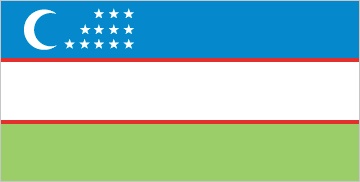Uzbekistan, flag of
Flag History

horizontally striped blue-white-green national flag with red fimbriations (narrow borders) between the stripes. In the upper hoist corner are a white crescent and 12 white stars. The flag's width-to-length ratio is 1 to 2.
Uzbekistan legalized the design of its new national flag on November 18, 1991. More than 200 proposals had been submitted in a flag design contest; the winning pattern had five unequal horizontal stripes, as in the flag adopted in 1952 when the country was known as the Uzbek Soviet (Union of Soviet Socialist Republics) Socialist Republic. The former flag's horizontal stripes of red-blue-red with white fimbriations symbolized communism and the water that allowed for cotton and other agricultural produce. In the new design blue is also for water but corresponds as well to the flag supposedly used by Timur, the great 14th-century ruler of an empire centred on Samarkand. The green stripe in the new flag suggests Islam but officially refers to nature, fertility, and new life. The white stripe is for peace and the striving for moral purity in thought and deeds. The red fimbriations refer to the life force inherent in all humans.
In place of the gold hammer, sickle, and star of the 1952–91 flag, the new design features 12 white stars and a white crescent. The stars correspond to the months of the year and to the constellations in the zodiac, thus recalling the astronomical sciences developed in medieval Uzbekistan. The crescent moon heralds the rebirth of an independent republic, although many Uzbeks and others are likely to see it also as a Muslim symbol. The contest-winning flag of 1991 omitted the crescent and stars from the reverse side of the flag, but they were subsequently added.
- Cape Cod Canal
- Cape Colony
- Cape Comorin
- Cape Coral
- Cape Corrientes
- Cape Dezhnyov
- Cape Diamond
- Cape emerald
- Cape Fear River
- Cape Flats
- Cape flora
- Cape Frio
- Cape Frontier Wars
- Cape Girardeau
- Cape Gracias a Dios
- Cape Hatteras
- Cape Hatteras National Seashore
- Cape Henry
- Cape Horn
- Cape Howe
- Cape, Jonathan
- Cape Krusenstern National Monument
- capelin
- Capella
- Capella, Martianus Minneus Felix